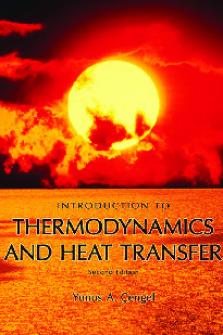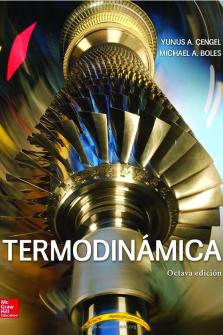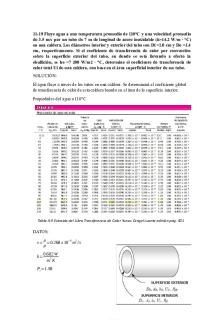Yunus A Cengel Introduction To Thermodynamics a Book Fi org PDF

| Title | Yunus A Cengel Introduction To Thermodynamics a Book Fi org |
|---|---|
| Author | Gado Sparda |
| Pages | 865 |
| File Size | 15.9 MB |
| File Type | |
| Total Downloads | 492 |
| Total Views | 646 |
Summary
Engineering Introduction to Thermodynamics and Heat Transfer 2nd Edition Çengel McGraw-Hill =>? McGraw−Hill Primis ISBN: 0−390−86122−7 Text: Introduction to Thermodynamics and Heat Transfer, Second Edition Çengel This book was printed on recycled paper. Engineering http://www.primisonline.com Co...
Description
Engineering Introduction to Thermodynamics and Heat Transfer 2nd Edition Çengel
=>?
McGraw-Hill
McGraw−Hill Primis ISBN: 0−390−86122−7 Text: Introduction to Thermodynamics and Heat Transfer, Second Edition Çengel
This book was printed on recycled paper. Engineering
http://www.primisonline.com Copyright ©2008 by The McGraw−Hill Companies, Inc. All rights reserved. Printed in the United States of America. Except as permitted under the United States Copyright Act of 1976, no part of this publication may be reproduced or distributed in any form or by any means, or stored in a database or retrieval system, without prior written permission of the publisher. This McGraw−Hill Primis text may include materials submitted to McGraw−Hill for publication by the instructor of this course. The instructor is solely responsible for the editorial content of such materials.
111
ENGNGEN
ISBN: 0−390−86122−7
Engineering
Contents Çengel • Introduction to Thermodynamics and Heat Transfer, Second Edition Front Matter
1
Preface 1. Introduction and Overview
1 8
I. Thermodynamics
26
Introduction 2. Introduction and Basic Concepts 3. Energy, Energy Transfer, and General Energy Analysis 4. Properties of Pure Substances 5. Energy Analysis of Closed Systems 6. Mass and Energy Analysis of Control Volumes 7. The Second Law of Thermodynamics 8. Entropy
26 27 62 114 162 204 256 300
II. Heat Transfer
375
Introduction 9. Mechanisms of Heat Transfer 10. Steady Heat Conduction 11. Transient Heat Conduction 12. External Forced Convection 13. Internal Forced Convection 14. Natural Convection 15. Radiation Heat Transfer 16. Heat Exchangers
375 376 404 474 528 574 614 656 716
Back Matter
767
Appendix 1: Property Tables and Charts (SI Units) Appendix 2: Property Tables and Charts (English Units) Index
767 811 849
iii
This page intentionally left blank
Çengel: Introduction to Thermodynamics and Heat Transfer, Second Edition
Front Matter
Preface
P R E F A C E BACKGROUND his text is an abbreviated version of standard thermodynamics and heat transfer texts, covering topics that the engineering students are most likely to need in their professional lives. The thermodynamics portion of this text is based on the text Thermodynamics: An Engineering Approach by Y. A. Çengel and M. A. Boles, and the heat transfer portion is based on Heat and Mass Transfer: A Practical Approach by Y. A. Çengel, both published by McGraw-Hill. Most chapters are practically independent of each other and can be covered in any order. The text is well-suited for curricula that have a common introductory course on thermodynamics and heat transfer. Instructors who desire to incorporate some coverage of fluid mechanics in their courses may wish to use the textbook Fundamentals of Thermal-Fluid Sciences instead, as it offers coverage of the essentials of fluid mechanics in addition to the thermodynamics and the heat transfer coverage in this book. It is recognized that all topics of thermodynamics, and heat transfer cannot be covered adequately in a typical three-semester-hour course, and, therefore, sacrifices must be made from the depth if not from the breadth. Selecting the right topics and finding the proper level of depth and breadth are no small challenge for the instructors, and this text is intended to serve as the ground for such selection. Students in a combined thermal sciences course can gain a basic understanding of energy and energy interactions, as well as various mechanisms of heat transfer. Such a course can also instill in students the confidence and the background to do further reading of their own and to be able to communicate effectively with specialists in thermal sciences.
T
OBJECTIVES This book is intended for use as a textbook in a first course in thermal sciences for undergraduate engineering students in their junior or senior year, and as a reference book for practicing engineers. Students are assumed to have an adequate background in calculus, physics, and engineering mechanics. The objectives of this text are • To cover the basic principles of thermodynamics and heat transfer. • To present numerous and diverse real-world engineering examples to give students a feel for how thermal sciences are applied in engineering practice. • To develop an intuitive understanding of thermal sciences by emphasizing the physics and physical arguments. The text contains sufficient material to give instructors flexibility and to accommodate their preferences on the right blend of thermodynamics and heat transfer for their students. By careful selection of topics, an instructor can spend one-third, one-half, or two-thirds of the course on thermodynamics and the rest on selected topics of heat transfer.
© The McGraw−Hill Companies, 2008
1
2
xvi
Çengel: Introduction to Thermodynamics and Heat Transfer, Second Edition
|
Front Matter
Preface
© The McGraw−Hill Companies, 2008
Introduction to Thermodynamics and Heat Transfer
PHILOSOPHY AND GOAL The philosophy that contributed to the warm reception of the first edition of this book has remained unchanged. Namely, our goal is to offer an engineering textbook that • Communicates directly to the minds of tomorrow’s engineers in a simple yet precise manner. • Leads students towards a clear understanding and firm grasp of the basic principles of thermodynamics and heat transfer. • Encourages creative thinking and development of a deeper understanding and intuitive feel for thermodynamics and heat transfer. • Is read by students with interest and enthusiasm rather than being used as an aid to solve problems. Special effort has been made to appeal to readers’ natural curiosity and to help students explore the various facets of the exciting subject area of thermal sciences. The enthusiastic response we received from the users of the previous edition—from small colleges to large universities all over the world— indicates that our objectives have largely been achieved. It is our philosophy that the best way to learn is by practice. Therefore, special effort is made throughout the book to reinforce material that was presented earlier. Yesterday’s engineers spent a major portion of their time substituting values into the formulas and obtaining numerical results. However, now formula manipulations and number crunching are being left to computers. Tomorrow’s engineer will need to have a clear understanding and a firm grasp of the basic principles so that he or she can understand even the most complex problems, formulate them, and interpret the results. A conscious effort is made to emphasize these basic principles while also providing students with a look at how modern tools are used in engineering practice.
NEW IN THIS EDITION All the popular features of the previous edition is retained while new ones are added. The main body of the text remains largely unchanged except that two new chapters are added, and two chapters are removed. The most significant changes in this edition are highlighted below.
EARLY INTRODUCTION OF THE FIRST LAW OF THERMODYNAMICS The first law of thermodynamics is now introduced early Chapter 3, “Energy, Energy Transfer, and General Energy Analysis.” This introductory chapter sets the framework of establishing a general understanding of various forms of energy, mechanisms of energy transfer, the concept of energy balance, thermoeconomics, energy conversion, and conversion efficiency using familiar settings that involve mostly electrical and mechanical forms of energy. It also exposes students to some exciting real-world applications of thermodynamics early in the course, and helps them establish a sense of the monetary value of energy.
Çengel: Introduction to Thermodynamics and Heat Transfer, Second Edition
Front Matter
Preface
Preface
COMPREHENSIVE PROBLEMS WITH EXTENSIVE PARAMETRIC STUDIES A distinctive feature of this edition is the incorporation of numerous comprehensive problems that require conducting extensive parametric studies, using the enclosed EES (or other suitable) software. Students are asked to study the effects of certain variables in the problems on some quantities of interest, to plot the results, and to draw conclusions from the results obtained. These problems are designated by a square computer-EES icon for easy recognition, and can be ignored if desired. Solutions of these problems are given in the Instructor’s Manual.
EXPANDED COVERAGE OF CONVECTION Forced convection is now covered in two chapters instead of one. Chapter 12 deals with the practical analysis of external convection while Chapter 13 deals with the practical aspects of internal convection.
UPDATED STEAM AND REFRIGERANT-134A TABLES The steam and refrigerant-134a tables are updated using the most current property data from EES. Tables A-4 through A-8, and A-11 through A-13, as well as their counterparts in English units have all been revised. All the examples and homework problems in the text that involve steam or refrigerant-134a are also revised to reflect the small changes in steam and refrigerant properties. An added advantage of this update is that students will get the same result when solving problems whether they use steam or refrigerant properties from EES or property tables in the Appendices.
LEARNING OBJECTIVES Each chapter now begins with an overview of the material to be covered and chapter-specific learning objectives to introduce the material and to set goals.
CONTENT CHANGES AND REORGANIZATION The noteworthy changes in various chapters are summarized below for those who are familiar with the previous edition. • The text now starts with a new introductory chapter Introduction and Overview where thermodynamics and heat transfer are introduced, dimensions and units are discussed, and a systematic problem solving approach is described. • The new Chapter 3 mainly consists of the sections Forms of Energy, Energy and the Environment, Energy Transfer by Heat, Energy Transfer by Work, Mechanical Forms of Energy, The First Law of Thermodynamics, and Energy Conversion Efficiencies. • Chapters 3 and 4 (now Chapters 5 and 6) on the first law of thermodynamics for closed systems and control volumes remain largely unchanged, but a new intutive “energy balance” approach is used in problem solving. Also, coverage is extended to include unsteady flow systems. • Chapter 6 (now Chapter 8) Entropy is revised considerably, and the section on Entropy Balance is moved to the end of the chapter.
3
© The McGraw−Hill Companies, 2008
|
xvii
4
xviii
Çengel: Introduction to Thermodynamics and Heat Transfer, Second Edition
|
Front Matter
Preface
© The McGraw−Hill Companies, 2008
Introduction to Thermodynamics and Heat Transfer • Chapter 7 Power and Refrigeration Cycles is deleted, but is available for downloading from the web site as a PDF file if needed. • Chapter 8, Steady Heat Conduction, is now replaced by two chapters: Chapter 9 Mechanisms of Heat Transfer, where the three basic heat transfer mechanisms are introduced; and Chapter 10 Steady Heat Conduction, where steady conduction problems in various geometries are solved. • Chapter 9 (now Chapter 11), Transient Heat Conduction, is greatly expanded to include the derivation of one-term solutions and additional cases of heat transfer in semi-infinite bodies. • Chapter 10, Forced Convection, is now replaced by two chapters: Chapter 12 External Forced Convection, where the basic concepts of convection are introduced and drag and heat transfer for flow over surfaces, including flow over tube banks, are discussed; and Chapter 13 Internal Forced Convection, where pressure drop and heat transfer for flow in tubes are presented. • Chapter 11 (now Chapter 14) Natural Convection is completely rewritten. The Grashof number is derived from a momentum balance on a differential volume element, some Nusselt number relations (especially those for rectangular enclosures) are updated, and the section Natural Convection from Finned Surfaces is expanded to include heat transfer from PCBs. • In Chapter 12 (now Chapter 15) Radiation Heat Transfer, the sections on Atmospheric and Solar Radiation and Radiation Shields are deleted. • In Appendices 1 and 2, the steam and refrigerant-134a tables (Tables 4 through 8 and 11 through 13) are entirely revised, but the table numbers are kept the same. Appendix 3 Introduction to EES is in the Student Resources DVD that comes packaged free with the text. • The conversion factors on the inner cover pages and the physical constants are updated, and some nomenclature symbols are revised.
LEARNING TOOLS EMPHASIS ON PHYSICS A distinctive feature of this book is its emphasis on the physical aspects of subject matter in addition to mathematical representations and manipulations. The authors believe that the emphasis in undergraduate education should remain on developing a sense of underlying physical mechanisms and a mastery of solving practical problems that an engineer is likely to face in the real world. Developing an intuitive understanding should also make the course a more motivating and worthwhile experience for the students.
EFFECTIVE USE OF ASSOCIATION An observant mind should have no difficulty understanding engineering sciences. After all, the principles of engineering sciences are based on our everyday experiences and experimental observations. A more physical, intuitive approach is used throughout this text. Frequently, parallels are drawn between the subject matter and students’ everyday experiences so that they can relate the subject matter to what they already know.
Çengel: Introduction to Thermodynamics and Heat Transfer, Second Edition
Front Matter
Preface
Preface
SELF-INSTRUCTING The material in the text is introduced at a level that an average student can follow comfortably. It speaks to students, not over students. In fact, it is selfinstructive. Noting that the principles of science are based on experimental observations, most of the derivations in this text are largely based on physical arguments, and thus they are easy to follow and understand.
EXTENSIVE USE OF ARTWORK Figures are important learning tools that help the students “get the picture.” The text makes effective use of graphics, and it contains a great number of figures and illustrations. Figures attract attention and stimulate curiosity and interest. Some of the figures in this text are intended to serve as a means of emphasizing some key concepts that would otherwise go unnoticed; some serve as page summaries.
CHAPTER OPENERS AND SUMMARIES Each chapter begins with an overview of the material to be covered and chapter objectives. A summary is included at the end of each chapter for a quick review of basic concepts and important relations.
NUMEROUS WORKED-OUT EXAMPLES Each chapter contains several worked-out examples that clarify the material and illustrate the use of the basic principles. An intuitive and systematic approach is used in the solution of the example problems, with particular attention to the proper use of units.
A WEALTH OF REAL-WORLD END-OF-CHAPTER PROBLEMS The end-of-chapter problems are grouped under specific topics in the order they are covered to make problem selection easier for both instructors and students. Within each group of problems are Concept Questions, indicated by “C” to check the students’ level of understanding of basic concepts. The problems under Review Problems are more comprehensive in nature and are not directly tied to any specific section of a chapter—in some cases they require review of material learned in previous chapters. The problems under the Design and Essay Problems title are intended to encourage students to make engineering judgments, to conduct independent exploration of topics of interest, and to communicate their findings in a professional manner. Several economics- and safety-related problems are incorporated throughout to enhance cost and safety awareness among engineering students. Answers to selected problems are listed immediately following the problem for convenience to students.
A SYSTEMATIC SOLUTION PROCEDURE A well-structured approach is used in problem solving while maintaining an informal conversational style. The problem is first stated and the objectives are identified, and the assumptions made are stated together with their justifications. The properties needed to solve the problem are listed separately. Numerical values are used together with their units to emphasize that numbers without units are meaningless, and unit manipulations are as important as manipulating the numerical values with a calculator. The significance of the findings is discussed following the solutions. This approach is also used consistently in the solutions presented in the Instructor’s Solutions Manual.
5
© The McGraw−Hill Companies, 2008
|
xix
6
xx
Çengel: Introduction to Thermodynamics and Heat Transfer, Second Edition
|
Front Matter
Preface
© The McGraw−Hill Companies, 2008
Introduction to Thermodynamics and Heat Transfer
RELAXED SIGN CONVENTION The use of a formal sign convention for heat and work is abandoned as it often becomes counterproductive. A physically meaningful and engaging approach is adopted for interactions instead of a mechanical approach. Subscripts “in” and “out,” rather than the plus and minus signs, are used to indicate the directions of interactions.
A CHOICE OF SI ALONE OR SI / ENGLISH UNITS In recognition of the fact that English units are still widely used in some industries, both SI and English units are used in this text, with an emphasis on SI. The material in this text can be covered using combined SI/English units or SI units alone, depending on the preference of the instructor. The property tables and charts in the appendices are presented in both units, except the ones that involve dimensionless quantities. Problems, tables, and charts in English units are designated by “E” after the number for easy recognition, and they can be ignored easily by the SI users.
CONVERSION FACTORS Frequently used conversion factors and physical constants are listed on the inner cover pages of the text for easy reference.
SUPPLEMENTS The following supplements are available to the adopters of the book.
ENGINEERING EQUATION SOLVER (EES) DVD (Limited Academic Version packaged free with every new copy of the text) Developed by Sanford Klein and William Beckman from the University of Wisconsin–Madison, this software combines equation-solving capability and engineering property data. EES can do optimization, parametric analysis, and linear and nonlinear regression, and provides publication-quality plotting capabilities. Thermodynamic and transport properties for air, water, and many other fluids are built in, and EES allows the user to enter property data or functional relationships. Some problems are solved using EES, and complete solutions together with parametric studies are included on the enclosed DVD. To obtain the full version of EES, contact your McGraw-Hill representative or visit www.mhhe.com/ees.
TEXTBOOK WEBSITE (www.mhhe.com/cengel) Visit the text website for general text information, errata, and author information. The site also includes resources for students including a list of he...
Similar Free PDFs

Fluid Mechanics by Yunus Cengel
- 970 Pages

solucionario mecanica de fluidos Yunus Cengel
- 1,445 Pages
Popular Institutions
- Tinajero National High School - Annex
- Politeknik Caltex Riau
- Yokohama City University
- SGT University
- University of Al-Qadisiyah
- Divine Word College of Vigan
- Techniek College Rotterdam
- Universidade de Santiago
- Universiti Teknologi MARA Cawangan Johor Kampus Pasir Gudang
- Poltekkes Kemenkes Yogyakarta
- Baguio City National High School
- Colegio san marcos
- preparatoria uno
- Centro de Bachillerato Tecnológico Industrial y de Servicios No. 107
- Dalian Maritime University
- Quang Trung Secondary School
- Colegio Tecnológico en Informática
- Corporación Regional de Educación Superior
- Grupo CEDVA
- Dar Al Uloom University
- Centro de Estudios Preuniversitarios de la Universidad Nacional de Ingeniería
- 上智大学
- Aakash International School, Nuna Majara
- San Felipe Neri Catholic School
- Kang Chiao International School - New Taipei City
- Misamis Occidental National High School
- Institución Educativa Escuela Normal Juan Ladrilleros
- Kolehiyo ng Pantukan
- Batanes State College
- Instituto Continental
- Sekolah Menengah Kejuruan Kesehatan Kaltara (Tarakan)
- Colegio de La Inmaculada Concepcion - Cebu









![Solucionario Yunus A. Cengel Michael A. Boles termodinámica 8 ED[0568-0685]](https://pdfedu.com/img/crop/172x258/1n2jgqo65z2q.jpg)

![[Barbara Oakley] A Mind for Numbers(Book Fi)](https://pdfedu.com/img/crop/172x258/1o2064dd72n0.jpg)

